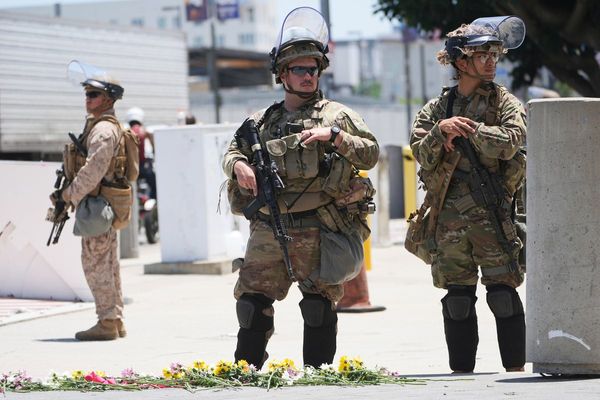Friday 21 March was a miserable day for more than 200,000 airline passengers who were planning to fly to or from London Heathrow airport. The UK’s busiest airport closed down almost completely for the day due to a fire at an electricity substation that provides Heathrow with power.
What went wrong – and could it happen again? The National Energy System Operator (NESO) has just published its final report into the incident. National Grid is blamed for the fire that triggered the catastrophic power outage. But the report also says Heathrow was aware that such an incident would have serious consequences, and that the airport accepted the risk as a “high-impact, low-probability event”.
These are the key questions and answers.
How did events unfold?
At 11.21pm on Thursday 20 March, a “supergrid transformer” at North Hyde substation near Heathrow caught fire and shut down. An adjacent transformer that had been “running on hot standby” switched into service, according to NESO, “with no interruption of supply to customers”. But as the fire spread, within 28 minutes all power from the substation was lost – affecting 71,655 customers, including Heathrow airport.
The power cut at the airport hit Terminal 2, parts of Terminal 4 and the access tunnel to Terminals 2 and 3 – “critical parts of the infrastructure”, according to Heathrow’s chief executive, Thomas Woldbye. He said that power was also lost to “buildings that house systems that are airport-wide, such as CCTV, some of the fuelling safety systems, and security locking systems for doors”.
Mr Woldbye was uncontactable at the time of the fire because his phone was switched to silent. In the early hours of Friday morning the chief operating officer, Javier Echave, took the decision to close Heathrow on safety grounds – despite the devastating emotional and economic consequences. The airport later said the decision was the correct one and that the CEO would have made the same call.
One hundred and twenty flights were in the air at the time, heading for Heathrow, and had to divert or fly back to where they had started. Nigel Wicking of the Heathrow Airline Operators’ Committee later said: “They had run out of space for aircraft to divert to in the UK. Aircraft were then going to Europe, and some were even halfway across Europe and were going back to base in India.”
More than 1,400 flights were cancelled as a result of the closure, and the airlines – which are responsible for caring for stranded passengers – lost up to £100m as a result, according to Mr Wicking.
Normal operations were restored three days later.
What have we learnt from NESO?
The transformer fire was “most likely caused by moisture entering the bushing causing a short circuit”, the report says. “The electricity likely then ‘arced’ (causing sparks) which combined with air and heat to ignite the oil, resulting in a fire.”
Crucially, the report says that “an elevated moisture reading” had been detected in oil samples from the transformer taken in July 2018. NESO says: “According to National Grid Electricity Transmission’s relevant guidance, such readings indicate ‘an imminent fault and that the bushing should be replaced’. While the reading was recorded in National Grid Electricity Transmission’s online system, the mitigations appropriate to its severity were not actioned.”
Subsequently, decisions were taken to defer basic maintenance on the transformer.
The report also says that none of the parties involved in supplying electricity to Heathrow knew how the airport’s internal electrical distribution network was configured, nor of the potential impact of losing a supply point.
Meanwhile, Heathrow knew that power disruption could “greatly impact operations” but “assessed the total loss of power to one of its three supply points as a high-impact, low-probability event”.
How prepared was Heathrow?
The report says: “Its internal electrical distribution network was not designed or configured in such a way as to take advantage of having multiple supply points to provide quick recovery following such a loss and was reliant on manual switching.” In other words, Heathrow could have organised its power network differently to be much more resilient.
The airport boss, Mr Woldbye, had previously said: “We have to power down maybe 1,000 systems before we do that switch, and then we have to switch it back on and power up 1,000 systems.”
While this process was happening, operating the airport was impractical, he said. “We would be able to land aircraft, but we would then be leaving them on the runways with passengers in them, not being able to process them because we did not have the safety. That is not an acceptable situation for passengers.”
What should change in future?
Electricity infrastructure needs to be properly monitored and maintained – with better risk assessment of the consequences of a failure. And all “critical national infrastructure” (CNI) including Heathrow airport should boost resilience so that “the loss of one supply point does not impact the entire CNI site”. The report recommends “the use of short duration uninterruptable power supply while switching takes place such that operations can be maintained”.
Ofgem has ordered an investigation. Akshay Kaul, director general for infrastructure at the regulator, said: “We expect energy companies to properly maintain their equipment and networks to prevent events like this from happening. Where there is evidence that they have not, we will take action and hold companies fully to account.”
What does National Grid say?
A spokesperson said: “National Grid has a comprehensive asset inspection and maintenance programme in place, and we have taken further action since the fire. This includes an end-to-end review of our oil sampling process and results, further enhancement of fire risk assessments at all operational sites, and re-testing the resilience of substations that serve strategic infrastructure.”
What does Heathrow say?
A spokesperson for the airport said: “Heathrow welcomes this report, which sheds further light on the external power supply failure that forced the airport’s closure on 21 March.
“A combination of outdated regulation, inadequate safety mechanisms, and National Grid’s failure to maintain its infrastructure led to this catastrophic power outage. We expect National Grid to be carefully considering what steps they can take to ensure this isn’t repeated.”
What happens next?
Now that responsibility has been apportioned, it may be that legal action begins to recover some of the financial losses – particularly those sustained by airlines.
Airports across the UK will be looking more closely at vulnerabilities – but putting mitigations in place for all “high-impact, low-probability” events would be extremely expensive, with the cost ultimately paid by passengers.







